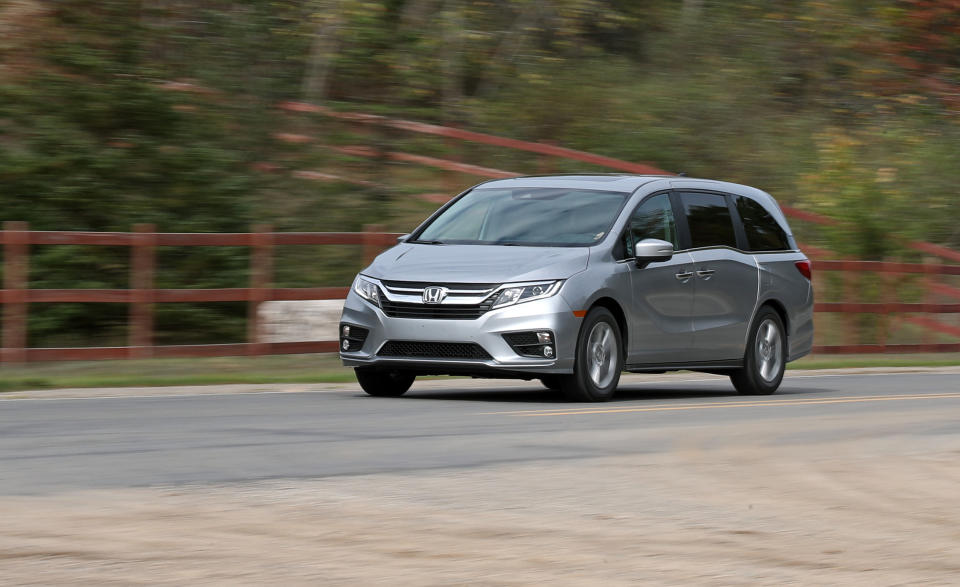2018 Honda Odyssey Nine-Speed Automatic

What It Is: Honda’s Odyssey is one of the most established players in the minivan game, and it was fully redesigned for the 2018 model year. Practicality and family friendliness remain its key tenets, along with a focus on driving enjoyment that’s rare among vehicles with this much people- and cargo-carrying capability. It has stiff competition, however, in the form of Chrysler’s latest minivan, the excellent Pacifica, which narrowly outscored the Honda to claim victory in our latest comparison test. We were still eager to spend more time with the new Odyssey, and we’re thousands of pleasant miles into a 40,000-mile long-term test of a top-trim 2018 Odyssey Elite.
Why We Tested It and How It Performed: Having had plenty of experience with the Honda van’s top trim level, which comes with a Honda-built 10-speed automatic transmission paired with its 280-hp 3.5-liter V-6, we were curious to see what the Odyssey’s other transmission, a ZF nine-speed automatic, could do. Particularly since Honda has promised to improve to this transmission’s shift smoothness over the less-than-impressive behavior we’ve experienced in the Honda Pilot, where it also does duty in some trims. In the Odyssey, the nine-speed mates with the same V-6 on the LX, EX, and EX-L models, the last of which was the subject of this review. As it turns out, losing one gear made little difference at the test track. The 126-pound-lighter Odyssey EX-L gave up only 0.1 second in the zero-to-60-mph dash and exactly matched the 10-speed’s quarter-mile time and trap speed of 15.2 seconds at 95 mph.

More so than accelerative performance, the 10-speed’s main reason for being is to improve fuel economy, and on that measure it succeeds somewhat. The tested nine-speed Odyssey fell 3 mpg short of the 10-speed’s 30-mpg result in our 75-mph highway fuel-economy test, although the EX-L’s overall average of 20 mpg in our hands was 1 mpg higher than the Elite’s. EPA ratings for the two transmissions are identical, however.
What We Like: Honda engineers have made good on the pledge to improve the ZF nine-speed automatic’s behavior compared with other Honda and Acura applications. In the Odyssey, it’s considerably more civilized than it was in our long-term 2016 Honda Pilot, where it hesitated and executed harsh shifts in a variety of part-throttle situations. It’s still not quite as sharp as the 10-speed, which exhibits quicker gearchanges and is more eager to downshift, but the nine-speed is smooth and does a good enough job managing the engine’s power. The EX-L also demonstrates the same satisfying dynamics as other Odysseys we’ve driven, with well-weighted and accurate steering, a controlled ride, and surprisingly sharp responses.

What We Don’t Like: The downside of the Odyssey’s responsive chassis tuning is a slight sacrifice in passenger comfort, as it’s not as cosseting as the Pacifica. Some may prefer the plush way the Chrysler soaks up bumps to the Honda’s firmer, sharper ride quality. A fair amount of road noise on the highway also is noticeable although not exactly bothersome.
Also, even though the Odyssey is a highly practical and spacious conveyance for people and stuff (as are most minivans), it gives up a bit of versatility to the Pacifica, mostly because of its second-row setup. While the Chrysler’s Stow ’n Go setup allows you to easily tuck away the second-row captain’s chairs into a bin beneath the floor, the Odyssey’s seats must be physically removed from the car, and they weigh a hefty 68 pounds each. Honda makes up for this deficiency somewhat with its clever Magic Slide seat arrangement, standard on all but the base LX, that give the Odyssey standard eight-passenger capacity (a $495 option for most of the Pacifica’s trim levels) and a few different second-row configurations, from a three-place bench to two captain’s chairs to pushing the two chairs together to form a two-place bench on one side of the car for easier access to the third row.
Specifications >
VEHICLE TYPE: front-engine, front-wheel-drive, 8-passenger, 4-door van
PRICE AS TESTED: $40,335 (base price: $30,965)
ENGINE TYPE: SOHC 24-valve V-6, aluminum block and heads, direct fuel injection
Displacement: 212 cu in, 3471 cc
Power: 280 hp @ 6000 rpm
Torque: 262 lb-ft @ 4700 rpm
TRANSMISSION: 9-speed automatic with manual shifting mode
DIMENSIONS:
Wheelbase: 118.1 in
Length: 203.2 in
Width: 78.5 in Height: 68.3 in
Passenger volume: 163 cu ft
Cargo volume: 39 cu ft
Curb weight: 4457 lb
C/D TEST RESULTS:
Zero to 60 mph: 6.7 sec
Zero to 100 mph: 17.1 sec
Zero to 110 mph: 21.6 sec
Rolling start, 5–60 mph: 6.9 sec
Top gear, 30–50 mph: 4.2 sec
Top gear, 50–70 mph: 4.7 sec
Standing ¼-mile: 15.2 sec @ 95 mph
Top speed (governor limited): 110 mph
Braking, 70–0 mph: 180 ft
Roadholding, 300-ft-dia skidpad*: 0.74 g
*stability-control-inhibited
C/D FUEL ECONOMY:
Observed: 20 mpg
75-mph highway driving: 27 mpg
Highway range: 520 miles
EPA FUEL ECONOMY:
Combined/city/highway: 22/19/28 mpg

 Yahoo Autos
Yahoo Autos 